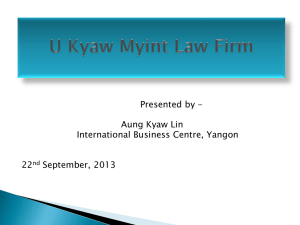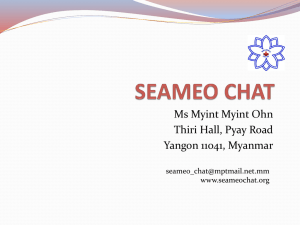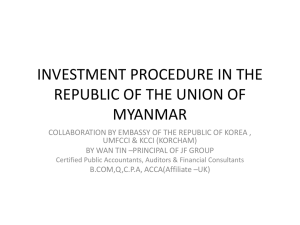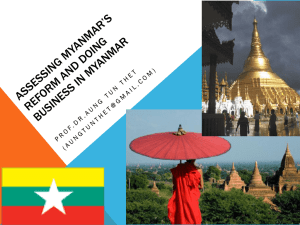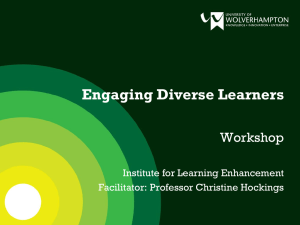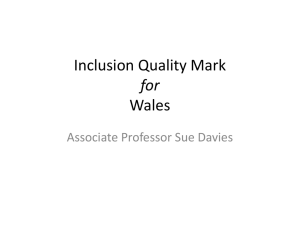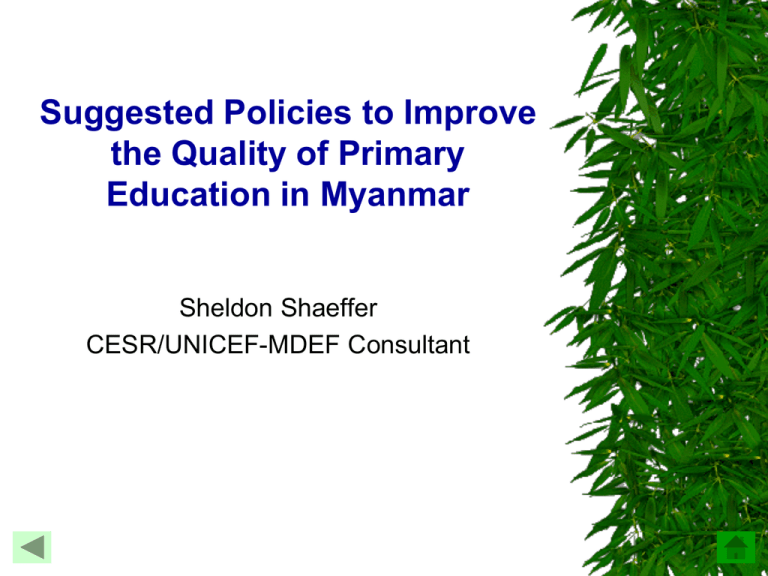
Suggested Policies to Improve
the Quality of Primary
Education in Myanmar
Sheldon Shaeffer
CESR/UNICEF-MDEF Consultant
Rethinking the Challenges
• Why do Grade 1 classes often have the least
experienced and/or trained teachers and the
highest pupil-teacher ratios? (And why is Grade 5
the opposite?)
• 5-10% of children in Myanmar have a disability –
perhaps 400,00 between the ages of 5-14. How
many are in school? How many could be in
school?
• Why do many children never enroll or fail in
school?
Why Children Fail/Drop out
3
Rethinking the Challenges
• Why is blame for school failure placed more
often on children and their families rather than on
the education system and school?
• Why do we use the word “drop-out” when most
“drop-outs” are usually “push-outs” from the
school?
• Why do many Ministry of Education staff,
especially head teachers, feel more accountable
UP the system rather than OUT to the
community?
• Why do most MOEs celebrate achievements in
national NERs rather than worry about subnational disparities and net NON-enrolment and
NON-completion rates?
Context: Myanmar’s Commitment to
Fulfilling the Right to Education
Myanmar has committed itself to fulfill the right to
education through a range of national and international
instruments:
• The Myanmar Constitution
• The Convention on the Rights of the Child
• The Convention on the Elimination of All Forms of
Discrimination Against Women
• The Convention on the Rights of Persons with
Disabilities
• Education for All
• The Millennium Development Goals
Key Messages
An education system of good quality must be:
• rights-based and equity-focused, with
equality and non-discrimination as central
principles
• based on a comprehensive, systematic
framework – vision, objectives, policies,
strategies, standards, and action plans
• child-centred, focused on the best interests
of the child
• child-seeking, actively looking for children
not in school and getting them into school
6
and succeeding
Key Outcomes for Myanmar’s Children
• Universal access to basic education,
starting with ECCD centres at age 3-4 and
kindergarten at age 5
• Successful early learning to lay the
foundations for later learning and life
• Completion of primary school and
equitable opportunities to continue to
higher levels of education
7
Key Goals for the Education System (1)
• A coherent, seamless transition from ECCD centres
through the early grades of primary school
• Readiness: “All children ready for school” and “all
schools ready for children”
• Inclusion: the elimination of all barriers to school and
to learning
• Healthy, safe, and protective learning environments
• Early mastery of numeracy and of literacy in
Myanmar and English based on a language policy
which promotes initial instruction and literacy in the
child’s mother tongue
• Enhanced teacher capacity in the competencies
needed to promote inclusive, child-friendly, and childcentred classrooms and schools
8
Key Goals for the Education System (2)
• Enhanced management capacity of head teachers
and inspectors/supervisors to both improve school
management and enhance classroom practice
• All schools meeting (and eventually exceeding)
“minimum service standards”
• Desired outcomes for all children in Myanmar:
critical thinking
creativity
respect for diversity and difference
demonstrating national values and behaviours
valuing their own culture and language, traditions
and heritage
9
Key Components of Quality Schools
An education system and schools of good
quality must be:
1. inclusive of all children
2. academically effective
3. healthy, safe, and protective
4. participatory of children, families, and
communities
5. with visionary, effective leadership
10
I. Inclusive:
(1) Getting Children Ready for School
• Provide parenting education on the principles and practice of
good early childhood development
• Provide all children aged 3-4 access to ECCD centres
• Target these centres on the most disadvantaged and
excluded groups – and individual children - of the population
• Provide all children aged 5 access to kindergartens
• Ensure that these ECCD centres and kindergartens are of good
quality: have adequately trained and remunerated teachers;
utilise inclusive, child-centred approaches; and use the
children’s mother tongue(s)
• Ensure inter-sectoral collaboration with Ministries of Health
and Social Welfare (and other relevant agencies) – with a
strong coordination mechanism -- to ensure adequate health,
hygiene, nutrition, and protection for young children 11
Inclusive:
(2) Including Those Most Excluded
• Strengthen the MOE’s EMIS/TEMIS to focus on issues of
exclusion: data on out-of-school children and disaggregated by
sex, location, economic quintile, surveys of children with
disabilities
• Make the education system and individual schools not only
child-centred but also child-seeking
• Expand and institutionalize non-formal education for those still
excluded from formal education
• Develop policies to target groups most excluded from
education
12
Inclusive: Learners in Remote Areas
• Devise affordable and feasible measures to attract
good quality teachers to remote and rural areas
• In small schools in rural and remote areas, set a
student-teacher ratio based not on one teacher per
class but rather one teacher per X number of
students (e.g., 25 students)
IT IS INEFFICIENT TO PUT ONE TEACHER IN
EVERY GRADE IN SMALL SCHOOLS.
• Actively promote the use of multi-grade teaching in
such small schools
MULTIGRADE TEACHING IS THE PEDAGOGY
OF FIRST CHOICE IN MANY MODERN
EDUCATION SYSTEMS AROUND THE WORLD.
13
Inclusive: Learners with Disabilities
• Actively find and enroll children with disabilities
• Ensure that any new schools and any renovations of
existing schools fulfill the international standards of
accessibility in terms of disability
• Provide pre-service and in-service teacher
training in the identification of developmental
delays and disabilities and in their possible
mitigation in the classroom
• Provide specialised resource teachers to support
teachers in “regular schools” toward the genuine
inclusion of learners in their classrooms
• Provide assistive devices to children who can
benefit from them (hearing aids and eyeglasses)
• Promote activities to develop positive attitudes
14
towards persons with disabilities
Inclusive: Learners from Ethnic Minorities
• Promote the use of mother tongue as the language
of instruction and for initial literacy (e.g., from ECCD
centres through Grade 3 or longer) beginning in
areas where most people speak one language
• For these selected languages, prepare necessary
learning materials
• Recruit and train more teachers from ethnic
minorities ensuring that they know both how to
teach using mother tongue and how to manage the
transition to the national language
oral Myanmar and English in the early grades
Myanmar literacy after mastery of the mother
tongue
English literacy after mastery of Myanmar (i.e.,
15
Grade 6)
Inclusive: Learners in Extreme Poverty
• Eliminate any extra incidental school expenses for
impoverished families not covered under “free
education”
• Explore the possibility of providing conditional
cash transfers to these families to encourage them
to enroll their children in school
• Research the extent and seriousness of the private
tuition fee problem and implement policies to
reduce its impact on teaching processes and on
poor families
16
Inclusive: Learners in Emergencies
• Ensure that the Ministry of Education has in place a
comprehensive Disaster Risk Reduction Plan
which can help the system and individual schools
anticipate, mitigate the effects of, respond to, and
recover from natural and manmade disasters and
emergencies
• As new schools are built and old ones renovated,
ensure that they meet the international standards for
disaster-resistant “safe schools”
• Ensure that children are able to continue education
during emergencies in a healthy, safe, protective
environment
17
Inclusive: Learners in (Post) Conflict Areas
Given that the consequences of violence against
children are both immediate and long-lasting and that
children exposed to violence and risk (including the
risk of unexploded ordnance) can experience physical
and psychological problems later in life and sometimes
harm themselves and/or others:
• Promote inclusive, conflict-sensitive education
as key to peace-building, contributing to the
development of positive attitudes towards all groups
and celebrating difference, which is fundamental to
building cohesive, peaceful, prosperous societies
• Promote mine-risk education in affected areas
18
Inclusive: Learners Affected by HIV/AIDS
• Develop and disseminate widely a clear, strong
Ministry of Education HIV/AIDS policy which
prohibits discrimination in the enrolment and
handling of HIV/AIDS-affected children in school
• Ensure that pre-service and in-service teacher
education programmes provide essential
information on both HIV and AIDS prevention
and transmission (including on how the virus is
NOT transmitted) and on the handling of students
affected by HIV and AIDS
• Promote programmes, materials, and practices
among teachers, communities and children that
promote positive attitudes and combat stigma
against PLWHA to support effective implementation
19
of polices
Other Excluded Learners
• Children from migrant families in Thailand who are
likely to return to Myanmar need systematic
approaches to recognition of prior learning and
reintegration into the education system
• Child soldiers who have been released from the
Tatmadaw need systematic channels of support to
reintegrate into the education system (formal/nonformal; vocational training)
• Other groups: girls (early marriage; pregnancy; sibling
care); street children and working children…..
AND MANY CHILDREN SUFFER FROM MULTIPLE
FACTORS OF EXCLUSION – A RURAL, ETHNIC
MINORITY GIRL WITH A DISABILITY HAS VERY
LITTLE CHANCE OF EVER GETTING TO SCHOOL 20
Assessing Disparities of Outcomes (youth
literacy rates - urban/rural, ethnicity, gender)
3 of every 4 women who die are indigenous. Ethnic disparities are
wider than in other countries with large indigenous populations.
Women in Alta Vrapaz are 4 times as likely to die than women from
Sacatepequez, near the capital
Learners in the Monastic System
Another 300,000 study in monastic schools…
• Promote greater collaboration among MOE, MORA,
and the monastic system to strengthen the MOE and
monastic systems (without sacrificing the latter’s
flexibility, inclusiveness, and community support)
• Collect more accurate data on the size and scope of
the monastic system, on its costs and budgets, and on
faith-based systems
• Improve monastic school system management –
goals, quality indicators, administrative guidelines, etc.
• Disseminate good practices of the monastic system
• Provide support to monastic education reforms –
i.e., the work of the Monastic Education Development
Group and of the Center for Promotion of Monastic
22
Education
Learners in Ethnic Education Systems
Perhaps 400,000 or more children study in ethnic
education systems both in Myanmar and in Thailand.
Exploring the nature and future of these systems is
essential in the further development of education.
• Depending on the circumstances, establish
stronger linkages between the formal education
system and each ethnic system in order to
strengthen the latter (without sacrificing their relative
independence, flexibility, and community support) in
order to promote a common vision for – and develop
steps towards – a stronger, more unified Myanmar
23
II. Effective:
(1) Successful Early Learning
• Collect accurate data at township and school level on teacher
characteristics and student-teacher ratios, by grade
• Implement policies to ensure that the early grades have the
lowest student-teacher ratios and the teachers most qualified to
promote early learning
• Develop a coherent, seamless educational framework for
children aged 3-8:
with a developmentally appropriate curricula, specialised
teacher education, and a child-centred approach and
learning environments
using the children’s mother tongue(s)
24
Effective: Successful Early Learning
• Develop early student assessment systems to identify,
respond to, and remediate developmental and learning delays
• Institutionalise regular Monitoring Learning Achievement
processes
• Improve the primary school curriculum by decongesting its
content, clarifying its desired learning outcomes, and inserting
relevant, local content
• Promote a serious, comprehensive reform of the entire
teacher management and development process, from
recruitment to retirement, based on:
a standard teacher competency framework
the reform of pre-service teacher education,
a strengthened quality assurance system, and a reinforced
25
school cluster process
Effective: (2) Completion and Continuation
• Develop flexible and child-friendly student assessment
mechanisms and tools which promote critical thinking and
creativity rather than rote memorisation
• Carry out research to better understand the process of and
reasons for student dropout/pushout and what can be done to
mitigate it
• Train teachers and encourage schools to identify early on
children at risk of failure and find ways to keep them in school
• Develop specific measures in primary school to encourage
students to continue to Grade 6 and beyond
• Ensure that secondary schools are equally child-friendly
26
III. Healthy, Safe, and Protective
• Provide schools with adequate health and sanitation facilities
including clean water, latrines, and hand washing practices
• Ensure that the school has a safe and protective environment
with explicit policies against abuse and harm including corporal
punishment
• Provide life-skills based education, knowledge, and skills
including those related to disaster risk reduction, peace
building, and conflict sensitisation
• Ensure schools have a comprehensive Disaster Risk
Reduction Plan and meet international standards for disasterresistant “safe schools”
27
IV. With Participatory School
Governance
• Develop mechanisms to promote the active participation of
students in school life and management
• Encourage parental and community involvement in the life of
the school as members of school-community committees and
as active participants in the development of school selfassessments (SSA) and school-improvement plans (SIP)
28
V. With Visionary, Effective Leadership
• Recruit head teachers and ATEOs on merit
• Use a standard competency framework to provide initial and
continuing training to head teachers and ATEOs in the
knowledge and skills essential to improve school management
and classroom practice in areas such as:
instructional leadership
the importance of early learning
the effective management of the school environment
school-based management
the effective and participatory implementation of school selfassessments and school improvement plans focused on the
efficient use of school resources and on the improvement of
student outcomes
29
With Visionary, Effective Leadership
• Ensure that indicators such as enrolment and attendance
rates, student-teacher ratios (by grade), dropout and completion
rates, and transition rates are regularly and accurately collected
and used as the basis for improvement planning (e.g., via
TEMIS) at both school and township levels
• Develop “minimum service standards” which all schools must
eventually meet in regard to issues such as student-teacher
ratios, teacher qualifications, the school environment, and
learner outcomes
30
Issues for Discussion
• Will such suggestions as these be useful in the formulation of a
future Basic Education Law (which would include post-primary)?
Are there any gaps?
• To what extent do they build on and support ongoing activities of
the Ministry, of development partners, and of other
organisations concerned with the development of education in
Myanmar? Specific examples?
• What changes – institutional, systems, financial, capacity
development, coordination, etc. – would need to take place in
the Ministry of Education to implement suggestions such as
these?
• Any other suggestions/comments?
31

